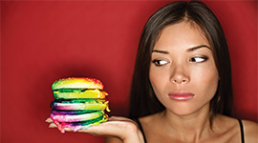How Color Affects Your Perception of Food
Eat With Your Eyes
Your taste buds play an important role in determining the four basic groups of taste, which are sweet, salty, sour, and bitter. When your taste buds come in contact with food, they send signals to your brain to interpret flavor. Because we look at our food before eating, however, our eyes send signals to our brain well before our taste buds get the chance. This can predetermine how we will perceive the taste and flavor of what we’re about to eat.
Color is often the first element noticed in the appearance of a food product. Humans begin to associate certain colors with various types of foods from birth, and equate these colors to certain tastes and flavors throughout life. For example, we may expect yellow pudding to have a banana or lemon flavor and red jelly beans to have a cherry or cinnamon flavor. In fresh foods, such as fruits and vegetables, we rely on the color to determine their level of ripeness and/or freshness. If the color of a food product does not match our expectations, we may perceive its taste and flavor differently – a psychological effect some food companies use to their advantage.
Showing One’s True Colors?
To give the impression of a certain taste, flavor, or quality, food coloring or dyes are added to processed, packaged, and even fresh foods. Adding a red colorant to the skin of an apple, for example, may influence consumers into believing the apple is sweeter in taste. In a study published in the Journal of Food Science, researchers found that people confused flavors when a drink did not have the appropriate color. A cherry-flavored drink manipulated to be orange in color was thought to taste like an orange drink, and a cherry drink manipulated to be green in color was thought to taste like lime.
Published in Fast Food Nation, a more extreme study dating back to the early 1970s offers some insight into how color affects our appetite and perception of food. Subjects in the experiment were served what appeared to be a normal-looking plate of steak and french fries. The room, however, was installed with specialty lighting that changed how the color of the food looked. Under this lighting effect, the participants thought the steak and fries tasted fine. Once the effects were turned off and lighting was returned to normal, it was revealed that the steak was dyed a blue color and the french fries were dyed a green color. Upon seeing this, many of the subjects lost their appetite and some became ill.
Color additives are also used to offset the effects of color loss during the manufacturing process because of exposure to light, changes in temperature, moisture, and storage conditions. At other times, additives are used to enhance the food’s natural color or to provide color to foods that are normally colorless. This can be seen in the seafood industry, where farm-raised salmon, typically an unappealing gray color, is dyed pink to give the impression that the fish is of high quality and very fresh.
The role color plays in our perception of taste has long been researched by food companies to better understand consumer behavior and how that impacts the perception of their products. Without these visual cues, our taste buds might get confused and not recognize the lemon flavor in pudding or cherry flavor in jelly beans that we’ve grown to expect. While food colorants have been highly debated over the past few years due to questionable health effects, food companies know that consumers determine the quality and taste of a food product long before their taste buds have had a chance to process it.
Green-colored french fries or gray-colored salmon anyone?
Like this article? Click here to sign up for our monthly Color Trends & Technology newsletter to stay updated on the element of color, best practices for controlling and evaluating the color of objects, educational seminars, and advanced technology for research and manufacturing environments.
The technological leader in color and light measurement solutions, Konica Minolta Sensing Americas helps organizations formulate, evaluate, and control color to meet product quality and operational goals more efficiently.










